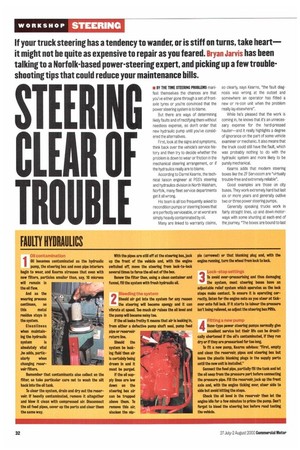FAULTY HYDRAULICS
Page 34

If you've noticed an error in this article please click here to report it so we can fix it.
' mlnation
Oil becomes contaminated as the hydraulic pump, the steering box and even pipe interiors begin to wear, and Kearns stresses that even with new filters, particles smaller than, say, 10 microns will remain in the oil flow.
And as the wearing process continues, so this metal residue stays in the system.
Cleanliness when maintaining the hydraulic system is absolutely vital ,he adds, partic ularly when changing reservoir fitters.
Remember that contaminants also collect on the filter so take particular care not to wash the silt back Into the oil tank.
To clear the system, drain and dry out the reservain If heavily contaminated, remove it altogether and blow it clean with compressed air. Disconnect the oil feed pipes, cover up the ports and clear them the same way. With the pipes are still off at the steering box, jack up the front of the vehicle and, with the engine switched off, move the steering from lock-to-lock several times to force the oil out of the box.
Renew the fitter then. using a clean container and funnel, fill the system with fresh hydraulic oil.
Bleeding thp system
2 Should air get inta the system for any reason the steering will become spongy and it can vibrate at speed. Too much air raises the oil level and the pump will become noisy too.
If the oil looks frothy it means that air is leaking In, from either a defective pump shaft seal, pump feed pipe or reservoir return line.
Should the system be leaking fluid then air Is certainly being drawn in and it must be purged.
If the oil supply lines are low down on the steering box air can be trapped above them. To remove this air, slacken the nip pie (arrowed) or that blanking plug and, with the engine running, turn the wheel from lock to lock.
dpb Lock-stop setting 4 To avoid over-pressurising and thus damaging the system, most steering boxes have an adjustable relief system which operates as the lock stops make contact. To ensure it is operating correctly, listen for the engine note as you steer at tickover onto full lock. If it starts to labour the pressure isn't being relieved, so adjust the steering box PIM.
.tting a p
Vane-type power steering pumps normally give
excellent service but their life can be drastically shortened if the oil's contaminated, If they run dry or if they are pressurised for too long.
To fit a new pump, Kearns advises: "First, empty and clean the reservoir, pipes and steering box but leave the plastic blanking plugs in the supply ports until the new unit is installed."
Connect the feed pipe, partially fill the tank and let the oil seep from the pressure port before connecting the pressure pipe. Fill the reservoir, jack up the front axle and, with the engine ticking over, steer side to side but avoid hitting the stops.
Check the oil level in the reservoir then let the engine Idle for a few minutes to prime the pump. Don't forget to bleed the steering box before road testing the vehicle.












































































































